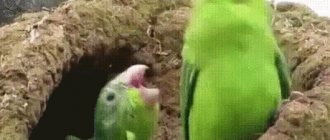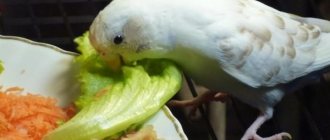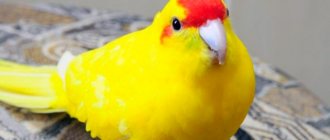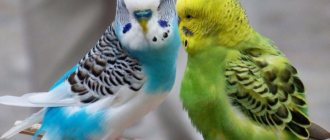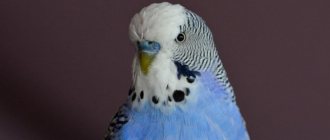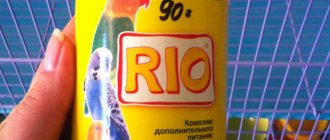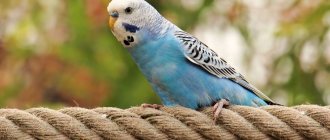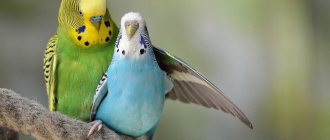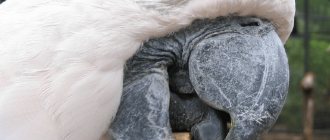Budgerigars can often be found in houses and apartments. Many people believe that they are unpretentious birds that do not require special care. But still, their well-being and good health depend on providing the necessary living conditions. Do not forget that there are various diseases of budgies that can cause serious harm to the health of the pet, and some of them can lead to the death of the feathered pet. To avoid fatal diseases, it is worth studying their types and treatment features.
How to understand that a parrot is sick
Budgerigars are strong birds that easily adapt to the conditions of a home or apartment. If you take proper care of him and provide him with all the necessary conditions for normal living, he can live 13-16 years. His state of health can be easily determined by his appearance.
Healthy birds look clean and tidy. They have an expressive look that is full of joy and interest in everything. They normally perceive external stimuli, make ringing sounds, chirp, and do not forget to clean their feathers and wash themselves.
But it is still worth remembering about the diseases of budgies and their symptoms. They can overtake every bird. It is enough not to remove the cage on time, not to close the window or not to change the food, and after a while the condition of the feathered pet may worsen.
Every owner of budgerigars should be wary of the following manifestations:
- The parrot suddenly becomes inactive and depressed;
- The pet is very thirsty;
- Difficulty and severe breathing;
- Formation of growths on the surface of the beak and paws;
- Movement coordination disorder;
- Vomiting and liquid droppings;
- The parrot sits at the bottom of the cage for a long time;
- Deterioration of plumage;
- There may be discharge from the eyes and beak.
If the parrot does not fly, is disheveled, unkempt, and does not show interest in others, then the owner should be wary. He probably has a dangerous disease that can cause serious complications.
Food poisoning
Its main reason is errors in the organization of the diet, for example, pure table salt getting into the parrot's feeder. It can also be caused by poor quality food. Main manifestations: diarrhea, cramps, drooping wings.
If poisoning is suspected, the pet is given an absorbent (activated carbon, smecta, filtrum). The coal tablet should be crushed, ½ of the resulting powder should be poured into a container with water, and the other half should be added to your favorite food. The course of treatment is no more than 3 days, if the symptoms do not go away, the cause of vomiting and problems with stool is not related to poisoning.
To normalize the microflora after poisoning, a course of probiotics is indicated.
Common diseases
If your parrot suddenly gets sick, you should be wary. Some diseases can go away on their own, but most can become severe and cause complications. Therefore, the owner must have an idea of what diseases can occur in birds and how to treat budgies.
Cold
It is important to remember that budgies have increased sensitivity to sudden changes in temperature, so even a draft can cause the development of a cold. For this reason, carefully monitor the vents and windows; they must be closed.
How can you determine that a parrot is sick? It is worth carefully examining his appearance; he will look unhealthy and inactive. The bird may sit in one place for a long time, and mucus may be released from its eyes and nose.
If your budgie has a cold, it will exhibit the following symptoms:
- Lethargy;
- Apathy;
- He may sneeze;
- Poor appetite;
- He sleeps constantly;
- The plumage becomes ruffled.
Before starting treatment, the bird must be taken to see a veterinarian. The specialist will conduct the necessary examination and determine the presence of a cold. Based on the data obtained, he will be able to select the appropriate treatment therapy.
At home, you can warm up your feathered pet using a lamp. Additionally, you can perform inhalations using tea tree oil. To improve the condition and speed up recovery, you can add chamomile decoction to the drinking bowl.
Ticks
When studying diseases of parrots, it is worth paying attention to ticks. Parasites often affect birds, they can come from anywhere - from other pets, the owner can bring them on clothes from the street.
When they appear, the bird begins to constantly itch. She experiences severe itching, which bothers her and causes discomfort. When these manifestations appear, it is worth moving the plumage apart; ticks can be found between the feathers. They can also be observed on the paws, near the eyes and beak.
It is important to remember that mites cause serious harm to the health of birds; they can cause the formation of growths on the surface of the paws or beak. Vaseline or vegetable oil works well; it will block the air and the pests will not be able to breathe, as a result they will die. For treatments, you can use aversectin or novertin ointment.
Goiter inflammation
Every owner of feathered pets should remember that many diseases of budgies can occur without any symptoms, so they can be ignored. Goiter inflammation is one of them. This pathological process cannot be detected at the initial stage, so it often develops into a complicated form.
The following factors may cause:
- Various toxic substances that birds can inhale;
- Consumption of low quality feed mixtures;
- Deficiency of useful elements;
- Using dirty water;
- Various complications after infectious diseases.
It is important to first study the symptoms and treatment features of budgerigar disease. Usually, when the goiter is inflamed, the bird does not eat food, it is lethargic, and practically does not drink. Over time, she begins to vomit, which may contain mucus.
Poisoning
Poisoning is a common ailment of birds. They can occur when consuming low-quality feed mixtures and unpurified water. These diseases in budgies can occur due to improper nutrition.
How can you tell if your parrot is sick? The main symptoms of poisoning include:
- The appearance of liquid droppings;
- Severe lethargy;
- Frequent vomiting;
- Poor appetite;
- Drowsiness.
In case of poisoning, the parrot should be given an absorbent. Smecta and Polysorb have a good effect. They are infused into the bird using a syringe. Dairy-free cereals are suitable for feeding. Additionally, it is worth warming your pet; a table lamp is suitable for this.
Paw injuries
Diseases of parrots can be associated with paws, namely with injuries to the limbs. They may experience dislocations, fractures, bruises, and sprains.
If a sick parrot experiences a deterioration in its condition, it is definitely worth taking it to see a veterinarian. He needs to be taken to a specialist urgently if the damaged paw is immobilized, red and swollen. The hospital will perform the necessary examination and select the appropriate treatment.
Vomiting, diarrhea and constipation
The occurrence of vomiting, diarrhea or constipation often occurs in a budgerigar with a poisonous disease. When poisoned, the bird begins to burp frequently after eating food. This may result from the following:
- When overfeeding birds;
- Insufficient supply of useful elements;
- Wrong diet;
- Liver problems;
- Peritonitis;
- Presence of parasitic organisms;
- Toxin poisoning.
Many infections in budgies are accompanied by vomiting and diarrhea. All this quickly leads to dehydration of the bird and subsequent death. In these cases, you should immediately contact a veterinarian; he will be able to save your feathered pet and prescribe effective treatment.
Lipoma
A lipoma is a tumor formation on the abdomen of a bird. It is located in the lower part of the abdomen, but can sometimes occur on other parts of the body. The tumor is benign. You may feel a ball moving under your skin.
If a budgie gets sick with this pathological process, then many owners may have a question - what to do in this situation? How can I help him? You can’t do anything on your own, otherwise you could harm your pet. It is important to visit a veterinarian immediately.
Treatment of this disease in budgies is accompanied by a special diet that is aimed at reducing weight. Lipoma is caused by obesity. The menu should include more cereals, vegetables and herbs. Also, periodically, the pet should be allowed out of the cage to fly.
Inflammation of the cloaca
When studying what ailments parrots have, it is worth paying attention to inflammation of the cloaca. This disease develops as a result of poor nutrition, lack of vitamins, and also when the bird eats difficult-to-digest food. Inflammation can develop due to poor quality cleaning of the feathered pet’s cage.
The following symptoms of the disease are observed in a budgerigar:
- Diarrhea;
- Gluing and clumping of feathers around the cloaca;
- Inflammation of the skin near the cloaca, signs of swelling;
- Significant weight loss;
- Lack of appetite;
- Decreased activity;
- The appearance of blood and mucous discharge.
If symptoms occur, you should contact your veterinarian. Only a doctor can conduct a quality examination and prescribe the necessary examination.
The Vet-Mir veterinary clinic is open 24 hours a day
You can invite an experienced ornithologist at any time of the day in Moscow and the Moscow region. Ambulance veterinary assistance will arrive as soon as possible at night, on weekends and holidays.
Call 24/7 for advice and treatment.
In ordinary cases, the arrival schedule is coordinated so that it is convenient for the veterinarian, the patient, and the owner.
Why we try not to accept birds at the veterinary clinic
First of all, we care about patients, and for them being in a homely atmosphere is more preferable; it will also be possible to prevent infection from visitors.
Making an appointment with an ornithologist is not easy, doctors are constantly traveling, but you can invite him to your place.
Stress for parrots is a serious provoking factor, and if possible it should be avoided, since stress alone can cause a bird to die.
Call and we will arrange a convenient time to meet with our doctor!
General services
| Prices for services in our clinic | In the clinic and at home |
| Ornithologist visiting your home | from 500 |
| Clinical examination, preliminary diagnosis, consultation | from 500 |
| Telephone consultation | for free |
| Therapy | from 150 |
| Surgery | from 150 |
| Ambulance at home (within an hour) | from 1000 |
Therapy
| Prices for services in our clinic | In the clinic and at home |
| Subcutaneous administration of medication to birds | from 200 |
| Intramuscular administration of medication to birds | from 150 |
| Intravenous administration of the drug to birds | from 500 |
| Bird dropper | from 1000 |
| Administration of the drug intraperitoneally, intraosseously | from 800 |
| Nerve receptor blockade in birds | from 500 |
| Tube feeding of birds | from 300 |
| Cleaning the horny cover | from 400 |
| Resuscitation treatment of birds | from 1500 |
| Infusion therapy | from 250 |
| Intravenous catheter placement | 500 |
| Removing the IV catheter | 500 |
| Removing the Marking Ring | from 200-1000 |
| Taking blood for laboratory tests | from 350 |
| Obstetrics in birds | 1 hour from 500 |
| Washing the crop | from 500 |
| Trimming: | |
| Beak | 500 |
| Claws | 500 |
| Krylyev | 500-1000 |
| Tail | 500-1000 |
Surgery and Traumatology
| Prices for services in our clinic | In the clinic and at home |
| Surgical treatment of wounds | from 200-1000 |
| Stitching | from 300-1500 |
| Application of a splint | from 300 |
| Opening abscesses, hematomas | from 300 |
| Removal of tumors | from 1000 |
| Goiter surgery | from 1500 |
| Cloaca surgery | from 1500 |
| Removal of foreign bodies | from 1500 |
| Eye amputation | from 2000 |
| Pelvic limb amputation | from 2500 |
| Osteosynthesis | from 10000-30000 |
| Surgery for goiter rupture | from 1500 |
| Egg extraction | from 500 |
| Anesthesia for birds | from 1500-3500 |
| Puncture of air sacs | from 1000 |
| Abdominal wall puncture | from 1000 |
Anesthesiology for birds
| Prices for services in our clinic | In the clinic and at home |
| Anesthesia | from 500 |
Ophthalmology
| Prices for services in our clinic | In the clinic and at home |
| Eyelid surgery for inversion, eversion | from 2000 |
| Exenteration of the eyeball | from 3000 |
Laboratory research
| Prices for services in our clinic | In the clinic and at home |
| Taking tests | 500 |
| Clinical blood test | 1000 |
| General clinical blood test | 1000 |
| Blood chemistry | 2000 |
| Microscopy of blood parasites | 700 |
| Smear microscopy | 700 |
| Examination of droppings for protozoa | 1000 |
| Examination of droppings for helminths | 700 |
| Determination of gender | 2000 |
| Histological examination | 2500 |
| Examination of droppings for helminths | 700 |
| Infectious anemia of chickens | 1500 |
| Test for infectious encephalomyelitis | 1500 |
| Analysis for infectious bronchitis of birds | 1500 |
| Analysis for infectious rhinotracheitis in birds | 1500 |
| Salmonellosis test | 1500 |
| Testing for trichomoniasis | 1500 |
| Tuberculosis test | 1500 |
| Examination of droppings for protozoa | 1000 |
| Analysis for psittacosis | 1500 |
| Analysis for pasteurellosis | 1500 |
| Avian influenza test | 1500 |
| Analysis for dysbacteriosis | 2000 |
| Analysis for avian mycoplasmosis | 1500 |
| Newcastle disease test | 1500 |
| Analysis for avian leukemia | 1500 |
| Test for Marek's disease | 1500 |
| Analysis for avian adenovirus | 1500 |
| Analysis for avian circovirus | 2000 |
| Analysis for yeast-like fungi | 1700 |
| Comprehensive analysis for anthropozoonoses | 4000 |
| General bacteriological analysis | 3000 |
| Gumboro disease | 1500 |
| Avian reovirus | 1500 |
Causes of diseases
Everyone knows that budgies are unpretentious birds that are suitable for keeping at home, but you still need to know their main diseases and methods of treatment. Many of them are dangerous and can be fatal. And in order to avoid them, it is necessary to study the main factors that provoke them:
- Incorrect content;
- Lack of hygiene;
- Non-compliance with feeding regimen;
- Improper cage cleaning;
- Use of low-quality feed;
- Vitamin deficiency;
- Drafts and dampness;
- Hypothermia, sudden changes in temperature.
Important! If you have identified the first signs of illness in a budgerigar, then you should separate it from other birds, otherwise it can infect them. You should also contact your veterinarian.
Cold
Key signs that should not be ignored:
- sleepy, disheveled appearance;
- sneezing;
- the nasal mucosa and oral cavity acquire a red tint;
- hard breath.
The bird acutely senses temperature changes and drafts and begins to tremble. It should be heated.
How to cure a parrot
If your pet develops a disease, a specialist can tell you how to properly treat the parrot. First, he will conduct the necessary examination, and after that he will be able to select the correct and effective treatment therapy. He will tell you what to do if your parrot gets sick.
Veterinary clinics
Treatment of parrots in a clinic is carried out under the supervision of a doctor. Usually he prescribes drugs and antibiotics that can suppress the development and eliminate the disease. Types of medications depend on the disease:
- For infectious pathologies, special antibiotics are prescribed for budgies. It is also recommended to use medications with anti-inflammatory and restorative effects;
- In case of poisoning, adsorbents and enzyme preparations are used - Smecta, Enterosgel;
- Vetom and Linex are used to normalize digestion;
- If the bird has internal bleeding and black droppings, then treatment is performed using Dicin;
- If the bird has ectoparasites, then the following external agents can be used - Aversectin ointment, Insektol, Celandine spray, Frontline.
Self-medication
Many owners of feathered pets are often interested in how and how to treat a parrot at home? Treatment can be carried out at home only in cases where the disease has just begun and is not serious. But in case of complications, it is better to consult a doctor.
Measures you can take at home:
- Improve nutrition;
- Ensure regular cleaning of the cage;
- Vitamins should be included in the diet;
- Carefully monitor poultry hygiene;
- From time to time, the parrot should be released from the cage so that it can fly.
If your pet has a cold, it is recommended to warm it up over a table lamp. He also needs to be given chamomile decoctions, teas with lemon and honey. Inhalations based on eucalyptus and menthol have a good effect. If the bird has wounds or ulcers, they can be treated with iodine or brilliant green. Potent drugs should be given under the supervision of a veterinarian.
Arthritis
Parrots' feet are the bird's weak point. If the perch is chosen incorrectly, is too small, or the bird has suffered from infectious diseases, arthritis or arthrosis may develop due to poor nutrition. In addition, the cause of joint inflammation can be microorganisms: staphylococci or streptococci.
Signs:
- The affected joint becomes purple in color.
- It gets hot.
- Because of the pain, the bird begins to constantly gnaw on the sore leg.
Only a veterinarian can make a correct diagnosis after an x-ray and blood test. Treatment includes a course of antibiotics.
Diseases dangerous to humans
When studying the issues of what budgerigars suffer from and how to treat them, it is also worth paying attention to diseases that can be dangerous to humans. You should not think that all diseases cannot be transmitted to people, this is not true. For this reason, doctors do not recommend having parrots for people who have allergic reactions or various chronic diseases.
So, you can become infected from a budgie if the bird has the following pathologies:
- Salmonellosis. This is an intestinal infection that occurs as a result of poor quality and insufficient nutrition of the parrot. Accompanied by diarrhea, vomiting, lethargy, decreased appetite, deterioration of plumage;
- Chlamydia. This is a dangerous disease that is quickly transmitted to humans from a sick bird. During it, the parrot experiences diarrhea, cough, discharge from the nose and eyes. A person experiences chills, headaches, discomfort in muscles and joints;
- Encephalitis. This disease is transmitted from mosquitoes to parrots and then to humans. During it, dysentery, pain in the abdominal area, fever, vomiting, and muscle spasms develop;
- Tuberculosis. Occurs in parrots with a weak immune system. In humans, it is accompanied by inflammation and enlargement of the lymph nodes.
Other paw problems
A serious disease is paralysis of the pelvic limbs, the cause of which is an interference with the nervous system of the bird. The parrot cannot stand up, falls on its side, and can only crawl, leaning on its beak. The main causes are bruises, stress, concussion as a result of hitting glass, and poisoning. Accompanied by convulsions and loss of consciousness.
Other problems:
- Cold paws. The limb takes on a bluish tint. There are several reasons: cold in the room where the bird is kept, a sedentary lifestyle leading to blood stagnation. To eliminate the pet, it should be warmed under a UV lamp.
- Hot paws. They are often a symptom of vascular disease.
- Peeling, growths. They can be caused by scabies mites, accompanied by itching, the pet’s constant desire to scratch, the skin becomes loose and crumbles. For treatment, the paws are lubricated with aversectin ointment. In addition, the appearance of growths may be associated with an excess of calcium.
- Naminas (ulcers). The main reason is an inconvenient perch, too small or made of plastic, which the bird cannot completely wrap its fingers around. Baking soda is used for treatment: baths and lotions.
- Gout. Occurs when there is a metabolic disorder that causes stagnation of uric acid in the body. with pathology, the bird begins to eat and drink a lot, the droppings do not change color, but become liquid. The bird is limping, in advanced form - it loses the ability to bend its fingers. For treatment, they use salicylic acid, methenamine, and place the bird on a strict diet: no animal products, but more greens.
- Gangrene (tissue necrosis). Appears after burns or frostbite. The limb changes color, going from light yellow or gray to dark red or even black. The leg stops functioning and the parrot suffers from severe pain. Often a limb has to be amputated.
Inflammation of the cloaca
The cloaca is the most important part of the excretory, digestive and reproductive systems of the parrot.
The main causes of its inflammation include:
- Lack of vitamins.
- Poor diet, consumption of indigestible food, large amounts of gravel in the stomach.
- Excess weight stimulates a decrease in muscle tone.
- Neoplasms in the cloaca.
- Young females have difficulties in the process of formation and release of eggs.
Symptoms:
- Weight loss.
- Poor appetite, constant thirst.
- Lethargy, apathy.
- The plumage around the cloaca sticks together.
- The cloacal ring becomes crimson and swells.
- Diarrhea with blood.
Treatment can only be prescribed by a veterinary specialist; most often, an aqueous mixture of vegetable oil is injected into the cloaca, and external treatment is carried out with furatsilin ointment. Additionally, you can use herbal decoctions, for example, marshmallow root helps to effectively relieve inflammation. In severe cases, antibiotics are prescribed.
To prevent pathology, you should include fresh grass and mineral components in the bird’s diet, and ensure that there is always clean water in the cage.
Paw injuries
Most often they occur in young birds that have just begun to master flight, but are also possible in mature individuals. Injuries include:
- bruises;
- cuts;
- ruptures;
- wounds;
- fractures.
The main signs of injury include:
- Impaired movement coordination.
- One wing is lower than the other, which is clearly visible when moving.
- Lameness.
- Rolling on the side.
- Redness or blueness on the paw.
To stop bleeding from wounds, hydrogen peroxide and alcohol-free iodine are used, then a bandage is applied, which should not be too tight and not interfere with blood circulation. For bruises and abrasions, trauma gel is used, which helps relieve pain and also has an antiseptic effect.
You can straighten a dislocation yourself, but if you lack experience, you should immediately visit a veterinarian. The help of a specialist will be required in case of a fracture; if left untreated, the limb may die.
Lipoma
It is a benign tumor that looks like a lump of subcutaneous fat. If the disease is ignored, the tumor will increase in size, squeezing the bird’s organs, causing discomfort. As a result, the digestive system suffers and death is possible.
Main reasons:
- Lipid metabolism disorders.
- The predominance of foods rich in fats in the diet.
- Violations of the regime.
- Low mobility of the bird.
Most often, the lipoma is localized in the lower abdomen; in some cases, it may be located under the tail or under the wings. The main symptom is low mobility: the parrot eats well, has no problems with bowel movements, but prefers to spend most of its time on a perch. In this case, the owner conducts a visual inspection and, if a lump is detected, should immediately contact a specialist.
Treatment involves reducing the growth rate of the tumor; the lipoma, as a rule, is not removed surgically.
Recommendations:
- Refusal of vitamin complexes, with the exception of vitamin B12.
- Excluding their diet from nuts, seeds, eggs, and sprouted grains.
- The emphasis in nutrition is on fruits, vegetables, and greens.
- There must be a mineral stone in the cage.
- The bird must move and fly as much as possible; it is important to organize a playground for it and select toys.
- Medications that can be prescribed include Karsil, Legalon 70, and lipoic acid.
Proper balanced nutrition and quality care are the best prevention of neoplasms.
